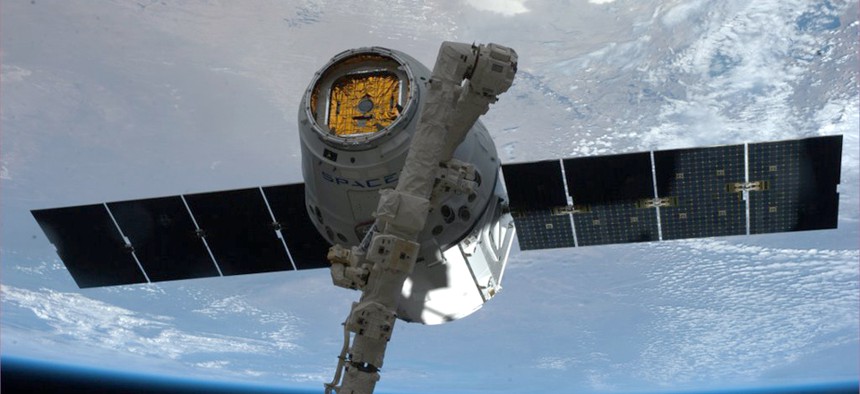What Do You Get When You Combine Space Exploration With Government Regs?

The third SpaceX Dragon commercial cargo spacecraft met the ISS in April. NASA
The future.
Missions to space already involve competing priorities and complex -- sometimes shady -- cooperations. Add to that space tourism, asteroid mining and more Federal Acquisition Regulations for a glimpse of the future of the U.S. space program.
“We’re going from a space economy that was really all government-funded for 60 or more years both on the military side and the NASA side, and we’re in the midst of a shift to a commercial space economy,” said John Roth, vice president of business development at Sierra Nevada Corporation’s space systems.
“It’s a huge shift in thinking about how we do space, and a huge difference in the targets that we go after in space,” Roth said at the Brookings Institution on Wednesday. “Obviously private companies have a much different view of what you need to get out of space than the science community does or the Defense Department does.”
In the near-term, government and private-sector priorities align. Companies like Sierra Nevada and SpaceX are vying for opportunities to take cargo and eventually astronauts to the International Space Station and hope to get other business for their space vehicles as well. Since NASA retired its space shuttle program in 2011, the agency’s astronauts have had to rely on Russian vehicles for lifts to space at more than $70 million a seat. Now even that pricey arrangement is threatened by political instability.
NASA and the Pentagon alone won’t have enough work to hold up an industry, so space companies are looking to other countries’ space agencies and the private sector. So far, roughly 550 humans have left Earth’s atmosphere since the onset of human space flight more than 50 years ago, Roth said. Another company, Virgin Galactic, already has more than 650 people signed up to take a trip to space (or almost to space) once that becomes possible. “We think there’s a huge potential market beyond what NASA wants with our vehicle,” Roth said, referring to his own company’s Dream Chaser, which could be used for space tourism in addition to ferrying NASA astronauts someday.
Companies are counting on the huge potential market beyond government, but in the meantime, they’re focused on government contracting, which isn’t always efficient or fair.
Last month SpaceX protested the award of an Air Force launch vehicle contract to a Boeing-Lockheed Martin venture called United Launch Alliance, which won the job on a sole-source basis without competition.
“It’s not surprising that the companies that usually win FAR contracts continue to win those FAR contracts,” SpaceX’s Vice President for Government Sales Adam Harris said at the Brookings event. “They know how to work the acquisition system better than new entrants.”
SpaceX is already delivering cargo to the space station for NASA and argues it is eligible to compete for this military contract as well. The company also complains that the contract and certain requirements were negotiated behind closed doors and never made public.
“SpaceX is not seeking to be awarded contracts for these launches,” the company said after filing a complaint with the U.S. Court of Federal Claims. “We are simply seeking the right to compete.”
As the market opens for federal space services, the types of contracts also are evolving. Sierra Nevada’s Roth said agency-company partnerships in space programs require a different contracting model. “Traditional government contracting is very hands off,” he said. “You’re limited in what dialogue you can have with your customer. They try to do everything in written requirements.” But for the Dream Chaser project, he said, NASA staff work with the company full time. “They come to every meeting, they review every drawing, they go through every decision process that we make so they know exactly what kind of product they’re going to get.”
For now, the race to space tourism is fueling innovation and competition that may drive down prices for NASA and the military. Even when public and private missions differ in the future, they may still overlap. Space companies could use government data to determine where to mine asteroids and other foreign bodies, for instance, noted Nadine Barlow, a professor of physics and astronomy at Northern Arizona University.
Interagency space collaboration could also be a model for public-private partnerships. Barlow described the 1994 Clementine mission to study the moon as a Defense project to test Reagan-era Star Wars technology. But there was room on board for NASA to send some cameras and instruments, as well. “We got some good scientific information from that mission even though it was a military mission and most of us didn’t know what it was actually doing,” she said.
“You don’t have the same goals but you have the same opportunities,” Michael Meyer, NASA’s lead scientist on the Mars exploration program, said about NASA and military space operations. His example was upper atmosphere flights “where you might be interested in the chemical makeup of the atmosphere while they’re interested in flying over and spying on different countries.”
Meyer conceded that private sector space priorities could one day be at odds with government’s. “Imagine 50 years from now SpaceX can send tourists to Mars,” he said. “Well, we may have a problem with the idea that if Mars has Martian life, we don’t really want to send humans there and accidentally wipe out the Martian life -- that would be too bad -- or actually have the humans come back carrying Martian life, which could threaten life here on this planet.”
For now, federal contracting rules are a trickier challenge for government-private collaboration than Martian life.



